B1.7 Read, represent, compare, and order decimal tenths, in various contexts.
Skill: Reading Decimal Tenths
Learning decimal numbers is closely related to understanding how decimal notation is an extension to the base ten number system that students have been working with up to this point. Decimal notation is commonly used in the International System of Units (SI) and in the monetary system, among other things. However, despite its frequent use in everyday life and in the classroom, decimal notation is far from being well understood and mastered.
In order to explore learning about decimal numbers, it is important to examine the terminology related to these numbers and decimal notation. A decimal number is a number that can be expressed in decimal notation with a finite decimal part (for example, 3.72; 12.135 64). The set of decimal numbers includes all whole numbers, because whole numbers can be expressed with a decimal part (for example, 3 = 3.0).
It is interesting to note that all decimal numbers can be expressed as decimal fractions, that is, fractions whose denominator is a power of 10.
In Grade 4, the study of decimal numbers is related specifically to the use of decimal notation to express decimal tenths. A number expressed in decimal notation is composed of two parts, the whole number part and the decimal part, separated by a decimal separator, which is a decimal point (period) in English and a decimal comma in French.
Example
The number \(8\frac{1}{2}\) is written in decimal notation as 8.5.

Source: translated from Guide d'enseignement efficace des mathématiques de la 4e à la 6e année, Numération et sens du nombre, Fascicule 3, Nombres décimaux et pourcentages, p. 28-29.
In teaching decimal numbers and related decimal notation, the focus is too often on learning procedures and rules, rather than the concepts that support them. This prevents students from developing conceptual knowledge of decimal numbers. Statements such as "you can add zeros after the last decimal place without changing the quantity, for example, 2.3 = 2.30" undermine understanding of the quantity represented by a decimal number and their use reduces learning about decimal numbers to rule following. According to the recommendations in Teaching and Learning Mathematics: The Report of the Expert Panel on Mathematics in Grades 4 to 6 (Ontario Ministry of Education, 2004a), effective mathematics instruction should focus on developing an understanding of the meaning of the concepts being taught. Since the decimal part of a number is, in fact, just a different way of representing a decimal fraction, it is essential that students have a solid understanding of fractions and place value before they are introduced to the concept of a decimal number. In terms of the quantity that a decimal number represents, connections must be made between the decimal part of the number and the concept of a decimal fraction. Paradoxically, the writing and reading of decimal numbers are more similar to those of whole numbers than to fractions.
The use of decimal numbers to express a quantity responds to a need to express quantities with more precision.
Example
Consider a diagonal of a square whose sides measure 1 m. If we try to describe the length of this diagonal using whole numbers, we can say that it measures 1 m and "part of one metre".

A more accurate measurement can be given by expressing this "part of a metre" in decimal notation. Using a ruler graduated in decimeters, we can determine that the diagonal is about 1.4 m.
Source: translated from Guide d'enseignement efficace des mathématiques de la 4e à la 6e année, Numération et sens du nombre, Fascicule 3, Nombres décimaux et pourcentages, p. 30-34.
Place Value Relationships
In Grade 4, students learn about decimals for the first time. They will deepen their understanding of the place values of digits and the relationship between place values. Decimal numbers are part of everyday life and understanding the place values to the right and left of the decimal point is essential.
The decimal point plays a significant role in decimal notation. It separates the whole number part from the decimal part and thus indicates the position of the whole-number units and the position of the fractional units.
It is essential that students recognize that the decimal part of a number represents a value less than 1 and that this value relates to the units (ones) place. For example, if we divide 1 unit into 10 equal parts, we have tenths.
This recognition of the role of the units (ones) digit is evidenced by the names given to the place values on either side of it. Thus, tens represent a quantity ten times greater than the unit, while tenths represent a quantity ten times lesser than the unit.
Note: Some students are under the impression that the decimal point is the centre of the decimal system. As a result, they tend to call the first position to the right of the decimal point the "oneths" place rather than the "tenths" place.
It is important that students also grasp the x 10 multiplicative relationship that exists between adjacent place values. Students have previously developed an understanding of this relationship in the study of whole numbers, such that each place has a value 10 times greater than the one to its right and 10 times less than the one to its left.
This multiplicative relationship is also true for decimal places.

Students can develop an understanding of this by using base ten blocks. The point is to demonstrate that just as 10 ones make 1 ten, 10 tenths make 1 whole. In this case, the rod would represent the whole, and the small cubes would represent the tenths.
It is common for junior students to write 13 tenths as follows.
0.13
Students must recognize that 10 tenths makes 1 whole, so 13 tenths is equal to 1 whole and 3 tenths. Therefore, we write 1.3.
Source: translated from Guide d'enseignement efficace des mathématiques de la 4e à la 6e année, Numération et sens du nombre, Fascicule 3, Nombres décimaux et pourcentages, p. 51-53.
Mental Representation
In order to develop number sense, it is important that students form images of quantities represented by many different numbers. In the case of decimal numbers, reading them correctly will help students form a better mental representation and draw on their knowledge of fractions (for example, 0.7 is read as "seven tenths", not "zero point seven"). Students should be encouraged to use multiple models to support the creation of various mental representations.
Example
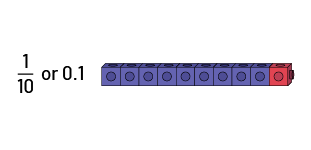
When representing decimal numbers using models, there is an adjustment to be made, as these same models were previously used to represent other concepts. Students need to understand that they must redefine what represents a whole. In the first of the two examples above, if the 10 train represents the whole and each cube is one tenth.
Students must also form a mental representation of decimal numbers greater than one. When reading such a decimal number, students must mentally picture the quantity it represents by interpreting the two parts that make up the number: the whole number part and the decimal part. For example, students must recognize that the number 8.2 represents 8 wholes and part of another identical whole. A quantity between 8 and 9 can then be visualized.
Source: translated from Guide d'enseignement efficace des mathématiques de la 4e à la 6e année, Numération et sens du nombre, Fascicule 3, Nombres décimaux et pourcentages, p. 36-37.
Skill: Representing Decimal Tenths
Students need to learn how to represent decimal numbers in a variety of ways, and recognize them in various representations. These skills help them make connections between numbers, their representations, and the quantities they represent. In some cases, the use of models facilitates the construction of representations.
Concrete Representations
In order to fully understand numbers, it is important that students be able to represent them concretely using manipulatives (for example, counters, ten frames, base ten blocks). Therefore, in the junior grades students should have opportunity to explore decimal numbers using these materials.
Example
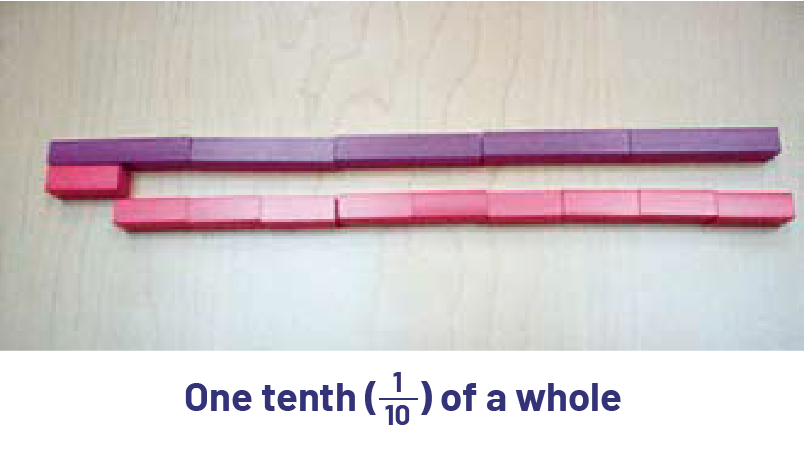
Once students have become accustomed to recognizing tenths, concrete materials can be used to introduce decimal notation. Here is a concrete representation of the number 2.4.

Base ten blocks are excellent tools to represent decimal numbers, since they highlight the x 10 multiplicative relationship between place values. However, it is very important to always clearly define the block that constitutes the whole, from which the other pieces will be defined. When studying whole numbers, the small cube was usually associated with one whole. However, if we choose the rod as the whole, then the small cube represents one tenth.
Example
The small cube represents 0.1 of a rod.

However, if we choose the flat as the whole, then the rod represents one tenth.
Visual (Semi-Concrete) Representations
Students can also develop a sense of decimal tenths by representing them in visual (semi-concrete) ways. For example, a disc divided into 10 equal parts can represent tenths.
Example

Strips and hundreds charts divided into 10 equal parts can also be used to represent decimal tenths.
Example

It is also important that students use set models to represent decimal tenths.
Example
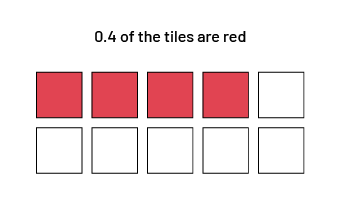
To develop a good sense of number, it is important that students explore different representations of the same quantity. For example, they can be encouraged to represent 0.5 in a variety of ways on a grid of \(10 \times 10\).
Examples

They can also be asked to show different visual representations to represent a given number. For example, three representations of 0.3 are shown below.

Students have learned to use a number line to locate whole numbers and to count to large numbers in intervals. They can also use it to locate decimal numbers.
Symbolic Representations
The conventional writing of decimal numbers is a symbolic representation of these concepts.
To symbolically represent decimal numbers, a decimal point is embedded in the number to separate the whole part from the decimal part.
Example
Three and one tenths

Writing decimal numbers requires an understanding of grouping. For example, “thirty-five tenths” becomes 3 and 5 tenths after grouping. The number 3 is in the ones position and the number 5 in the tenths position, which is represented by 3.5.
This relationship between writing a decimal number and groupings can be understood by exploring decimal numbers using concrete and visual representations that allow one to "see" the groupings.
It is important to distinguish between the digit in the tenths position and the amount of tenths in the number. For example, in the number 2.1, the digit in the tenths position is 1, but it could also be said that there are 21 tenths. Thus, if we want students to identify the digit in the tenths position of a number such as 2.3, we should ask the question "What digit is in the tenths position in the number 2.3?" rather than "How many tenths are in the number 2.3?
Representations Using Words
How students learn to read decimal numbers can affect their understanding. If they are taught to read the number 0.7 by saying "zero point seven," the meaning of the decimal notation is left out. This way of reading a decimal number is simply a sequential listing of the symbols that make up the number, just as it would be if the number 123 were read as "one, two, three". However, insisting on reading this number as "seven tenths" emphasizes the meaning of the notation. This way of reading decimal numbers gives students the opportunity to visualize the 7 parts of 10 and has the advantage of reminding them of the relationship between a decimal number and its decimal fraction equivalent. It also allows students to refer to a decimal number by its name.
It is important that teachers model this way of reading decimal numbers at all times. The numbers 12.3 and 1013.7 read "twelve and three tenths" and "one thousand thirteen and seven tenths" respectively. Note that when reading a decimal number, the whole number part is read as if it were a whole number, the word "and" (not "point") is used to connect the two parts, and the decimal part is read according to the place value of the far right decimal digit in the number.
Note: Some students may confuse the terms ten and tenth when reading because of their phonetic similarity.
Source: translated from Guide d'enseignement efficace des mathématiques de la 4e à la 6e année, Numération et sens du nombre, Fascicule 3, Nombres décimaux et pourcentages, p. 57-69.
Skill: Comparing and Ordering Decimal Tenths
Ordering is based on a comparison of numbers. One of the great advantages of decimal notation is the ease by which decimal numbers can be compared and ordered. For example, it is much easier to compare the numbers \(\frac{1}{2}\) and \(\frac{2}{{10}}\) when expressed in decimal notation, 0.5 and 0.2.
Ordering should be addressed by comparing decimal numbers in contextualized situations. For example, "Remi jumped 3.5 m and Samantha jumped 3.7 m. Which of them had the longer jump?" Students can respond and justify their choice if they understand place value and magnitude. The number line is a powerful visual model for comparing decimal numbers. To place 3.5 and 3.7 on a number line, students can represent the tenths from 3.0 to 4.0. They can then conclude that 3.5 < 3.7, so Samantha has made a longer jump than Remi.

Students with good number sense can also compare 3.5 m and 3.7 m by first noticing that they represent two jumps greater than 3 m. Then they can compare tenths to notice that the first number is 5 tenths, or 5 decimetres, while the second is 7 tenths or 7 decimetres.

Source: translated from Guide d'enseignement efficace des mathématiques de la 4e à la 6e année, Numération et sens du nombre, Fascicule 3, Nombres décimaux et pourcentages, p. 54.
Skill: Reading, Representing, Comparing and Ordering Decimal Tenths in Various Contexts
Context is all the information surrounding a given situation. To understand the meaning of the quantity represented by a decimal number, students must analyze it in its context. Like a fraction, a decimal represents a part of a whole. The magnitude of the quantity represented by a decimal is therefore entirely dependent on the magnitude of the whole.
Emphasize that the context helps clarify the quantity represented. For example, if 2.3 is mentioned, students should understand that this number represents 2 wholes and another \(\frac{3}{{10}}\) of a whole. But, if it is specified as 2.3 cm, they can form a picture of the quantity in context, that is 2 whole centimetres and an additional \(\frac{3}{{10}}\) of a centimetre.
However, in some situations, it is important to recognize that decimal numbers do not refer to the same whole.
Example
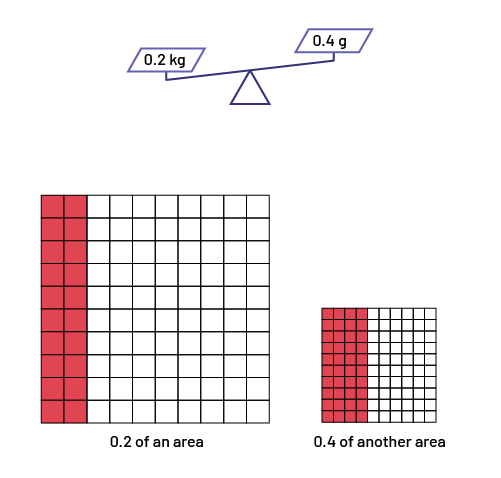
In these examples, even though the number 0.2 is less than the number 0.4 (\(0.2 < 0.4\)), 0.2 kg is a greater mass than 0.4 g because the units are larger, just as 0.2 of the large square is a larger area than 0.4 of the small square.
Headlines often provide topics for discussion that can help students understand and interpret decimal numbers.
Example
During a class discussion, teachers can ask questions that help students analyze the headline:
New world record, a 13.4 kg apple!
- Is it important to specify the 0.4 kg in the mass of the apple? Why or why not?
Source: translated from Guide d'enseignement efficace des mathématiques de la 4e à la 6e année, Numération et sens du nombre, Fascicule 3, Nombres décimaux et pourcentages, p. 40-41.
Knowledge: Decimal Number
Set of Decimal Numbers (ⅅ)
Decimal numbers are numbers that can be expressed with a finite decimal part (for example, 3.72; 0; 12.135 64). This includes all whole numbers, because they can be expressed with a decimal part (for example, 3 = 3.0). They also include some fractions, such as \(\frac{2}{5}\) and \(\frac{3}{{16}}\), since \(\frac{2}{5}\; = \;0,4\) and \(\frac{3}{{16}}\; = \;0.187\;5\). However, a large number of fractions, such as \(\frac{1}{3}\) and \(\frac{7}{{11}}\), cannot be expressed as decimal numbers because their decimal expression requires an infinite number of decimal places (\(\frac{1}{3}\; = \;0.333\;3 \ldots \;{\rm{and}}\;\frac{7}{{11}}\; = \;0.636\;363 \ldots \)).
Examples
\(5 = 5.0 = \frac{5}{1}\)
Since natural numbers are all whole numbers and whole numbers are all decimal numbers, we can represent the relationship between the sets of numbers by the Venn diagram below.
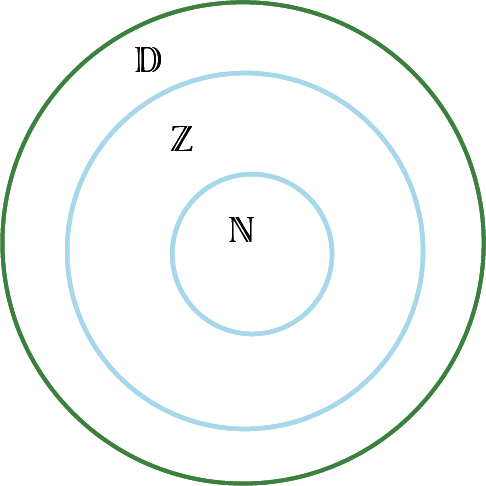
Note: There is no such thing as a set of decimal numbers. The name decimal number simply means that the expression of the number contains a decimal point. Thus, a decimal number can be a decimal number (e.g., 0.45), a periodic number (e.g., 0.333…) or an irrational number (e.g., 3.141 5…).
Source: translated from Guide d'enseignement efficace des mathématiques de la 4e la 6e année, Numération et sens du nombre, Fascicule 2, Fractions, p. 42.
Knowledge: Tenth
The decimal point plays a significant role in decimal notation. It separates the whole part from the decimal part.
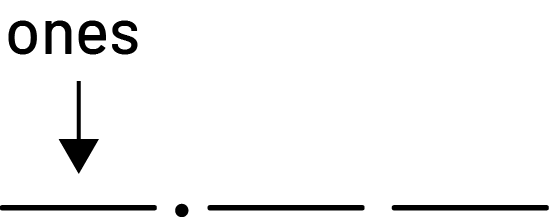
The position of the ones defines the whole according to which are formed on the one hand the tenths, the hundredths and the thousandths and on the other hand the tens, the hundreds and the thousands. It can therefore be said that the ones, identified by the decimal point, is at the heart of the decimal system.
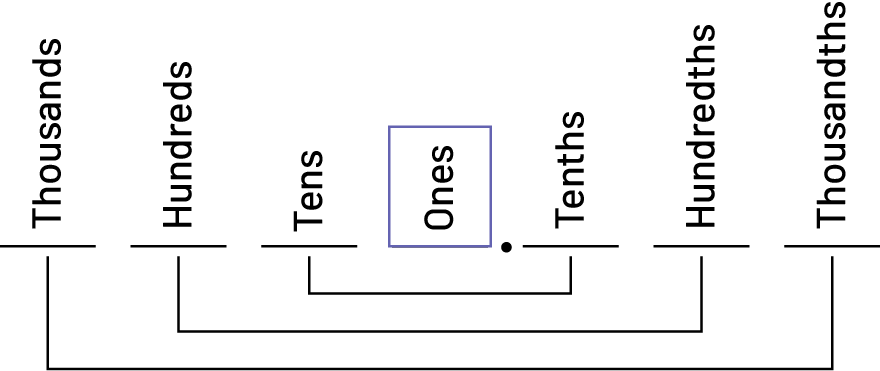
This recognition of the role of the ones digit is evidenced by the names given to the place value of the digits on either side of the unit. Thus, the tenths represent a quantity ten times smaller than the unit.
Source: translated from Guide d'enseignement efficace des mathématiques de la 4e à la 6e année, Numération et sens du nombre, Fascicule 3, Nombres décimaux et pourcentages, p. 51.
